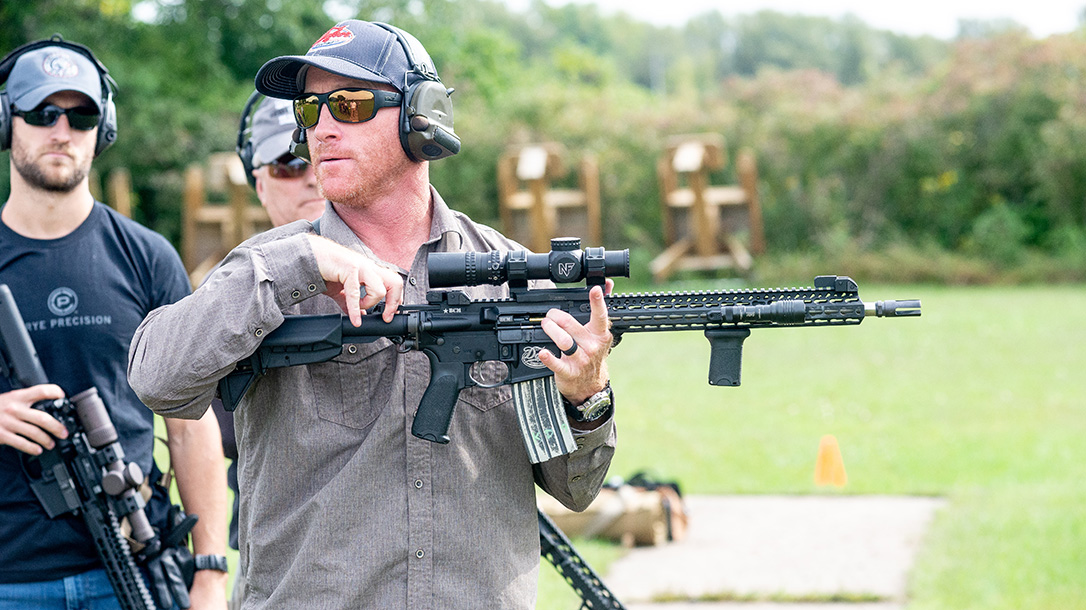Low power variable optics (LPVs) are nothing new, but they have slowly gained a following among the AR crowd.
Definitions vary, but generally, LPVs are riflescopes with adjustable 2X to 8X magnification. Many LPVs only have a bell at the ocular lens and a straight tube with a consistent diameter to the objective lens. Some variations have a double-bell appearance of a high- magnification optic in a shorter, smaller profile.
Advertisement — Continue Reading Below
Within variations used for tactical applications, most shooters prefer an adjustable daytime-visible dot at the center of the crosshairs. Reticles vary from a simple pair of crosshairs or a single German-style center post to complex ranging and holdover patterns.
Advantages of Low Power Variable Optics
Their styles and configurations may differ, but low power variable optics offer AR shooters several advantages.
First, like long-range tactical scopes or hunting scopes, most LPVs are built with coatings that gather light and can amplify and filter ambient light to provide magnification and longer durations of visibility. This allows you to better identify threats at greater distances in more lighting conditions and with greater accuracy than via the naked eye or through a red-dot sight.
Advertisement — Continue Reading Below
Also, these scopes are adjustable for conditions and the shooter’s vision. Whether because of age, genetics or variations in your eye, such as astigmatism, an LPV can be adjusted at the ocular lens to compensate for visual deficiencies of focus or night-vision issues.
What About Red Dots?
So if low power variable optics are so great, why wouldn’t everyone throw their red dots away and immediately mount one on their AR’s rail? Setting cost aside, the red dot has the advantage of being immediately intuitive. There’s the target. Put the dot over it, and press the trigger. The learning curve is brief and simple.
There are also arguments of speed. Some believe LPVs require more effort to gain a sight picture at close range and therefore slow reaction times. Kyle Defoor, of Defoor Proformance Shooting, disagrees, however, as his personal experience — and that of his students — indicates there’s no reduction in speed.
Advertisement — Continue Reading Below
“Typically, a lack of speed between the optics is a training issue. Specifically, it’s a mounting and setup issue,” he said. “Students forget to use the true 1X and daytime-visible red dot at close range or adjust the magnification at varying distances. Some forget, don’t change it, don’t change it correctly or stay on max power too long. The only drawback I have seen is that some students complain after three days of having a slightly heavier rifle. But ultimately, a red-dot sight is suitable to 200 yards in perfect lighting—realistically about 100 yards given varying conditions of light, weather, smoke and other factors. LPVs give you excellent target identification and accuracy out to 400 yards.”
Other Factors
The most legitimate criticism might be weight. An LPV is bigger and requires an equally larger mount. Some combinations can add almost 2 pounds, compared to less than a pound for a red dot like the Aimpoint Micro T-1 and its mount.
Advertisement — Continue Reading Below
Ruggedness is also brought up, as many red dots have made a living on torture tests. That might be a fair assessment, but many Special Missions Unit assaulters have been running LPVs for years in the most austere environments.
True, all LPVs are not the same, and budget is always a factor, just as with a red dot.
Things to Consider
So if you’re on the fence about changing your current RDS setup, consider a few questions:
Advertisement — Continue Reading Below
- Are you more likely to use your AR in a close-quarters home-defense scenario than in an open environment?
- Can you confidently and accurately engage the targets you expect to encounter with a red dot?
- Are your eyes and visual acuity static enough to the point where you wouldn’t need an optic with some adjustment capabilities?
- Would an extra 10 to 12 ounces on your weapon system significantly affect your ability to perform to expectations?
Defoor’s Setup
If you answer no to one or more of these questions, you might want to consider an LPV. Your life and those of your loved ones might be on the line. But to help you further, we asked Kyle Defoor what features he looks for in an LPV.
Deefor said he looks for a true 1X setting, a mil reticle and turrets, a daytime-visible red dot with a locking on/off switch, a quick-detach mount like those from Bobro, and either a first- or second- focal-plane reticle, but the former is better beyond 6X magnification.
“I run a red dot rather than a green one,” Defoor said. “It’s a personal preference from 20 years of experience. I run simple mil hash marks or a mil-dot. I leave more complex reticles for big scopes and ranges outside of 800 yards. For most classes, I am running a Nightforce or Vortex Razor HD with a Bobro extended mount. I have also found an H2 buffer to be a simple all-around replacement that lets my rifle consistently feed and cycle no matter the barrel length, load or setup, unless you’re getting into subsonic rounds and larger calibers.”
Advertisement — Continue Reading Below
And when it comes to the current market offerings for low power variable optics, from top shelf to bargain buy, he recommends the Nightforce 1-8x24mm ATACR, the Nightforce 1-8x24mm NXS and the Vortex 1-6x24mm Razor HD Gen II.
For more on Defoor, please check out Defoor Proformance Shooting.
This article is from the premiere issue of Tactical Life’s Stealth 2019 magazine. To read the entire article, grab your copy at OutdoorGroupStore.com.
Advertisement — Continue Reading Below





















